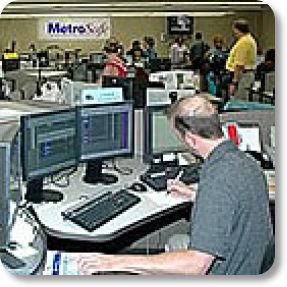
It will be the largest investment in public safety since the Louisville and Jefferson County governments merged in 2003.
The city is about to sign a $22.8 million contract with Motorola to build the backbone of a digital communication system, known as MetroSafe, that will allow firefighters, police and paramedics to communicate easily.
And it will do more:
Police can have mug shots or video transmitted to their cruisers.
Firefighters can scan building plans before entering a burning structure.
Paramedics can review medical records while rushing a patient to the hospital.
The entire project will cost over $71 million, with construction on the communication towers to begin in July and take 18 to 24 months.The city managed to dramatically cut the cost of the system's backbone after receiving only one bid for it last year: $59 million, from Motorola. City officials rewrote the specifications, and a new round of bidding brought proposals from two companies, with MA-Com's bid $69,295 lower than Motorola's.
The earlier cost estimate prompted some on the Metro Council to question whether costs for the project could be controlled.
For Paul Barth, of the Jefferson County Fire Chiefs Association, it is a worthy investment.
Just a few years ago suburban fire departments couldn't communicate at all with Louisville firefighters, he said. "Now we can talk to them, but it's not instantaneous," Barth said. "With MetroSafe, it will be instantaneous. Seconds count in an emergency, so that's what we need."
This contract adds to the $35 million spent on the first two phases of the project.
The final phase will involve buying radios and video-display terminals for emergency vehicles -- between 4,000 and 5,000 units, estimated in 2004 to cost $15 million.
In the latest contract, the $22.8 million will buy six new communication towers, along with the computer and microwave equipment necessary to tie it all together. It's the most expensive and technically challenging aspect of the project.
The new system replaces a hodgepodge of equipment that often provides poor reception and confounds efforts of city and suburban agencies to speak with each other. The original system was built in 1970.
MetroSafe Director Doug Hamilton said the investment is crucial, yet nearly invisible to most people. "It's not something you can point to like a museum, or arena," he said. "... But we know this is as important as all those tourist attractions because they can't exist if people don't feel safe and secure in the community."
Metro Mayor Jerry Abramson has made a new communication system the priority of his administration since taking office in 2003.
The original cost estimate was $50 million, but that has grown to $71 million today -- a figure likely to be exceeded after purchase of the radios. But whatever the final amount is, it will be far less than officials feared in October.
Motorola's original $59 million bid was nearly double the maximum officials expected to pay, and caused them to rewrite the specifications.
The new specifications said companies would have to build the towers on government-owned land, that the city would develop those sites and that the companies could design the system any way they wanted as long as 95 percent of the county was covered. That brought costs down, Hamilton said.
Still, the growing cost has opened the door for political criticism, particularly from Metro Council member Kelly Downard, who was Abramson's opponent for mayor last year.
Downard, R-16th District, has called the MetroSafe process "awful."
"I'm encouraged that it's no longer going to cost $100 million, but I'm discouraged because we seem to get a different number all the time," Downard said. "I will need to see, on the ground level from the users, whether this thing works."
The two bids were evaluated by a team of 10 city officials, who were led by Roger Schipke, a former vice president at General Electric. After a months-long process, Motorola was the unanimous choice.
"Both companies could have done it," Schipke said. "Both bids were very competitive. Motorola's coverage looked a little stronger. Motorola had a slight edge on price and a slight edge on the technology. The two things working together got Motorola the job."
Abramson called the project the "most important" his office has worked on in the past four years. He added that the decision to reject the first Motorola bid and recast the specifications was difficult because it was uncertain whether a new round of bids would produce a lower price.
"I think we've done this right," he said. "I feel really good about it for our hometown."





